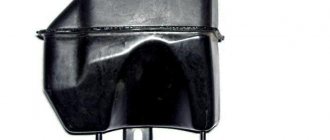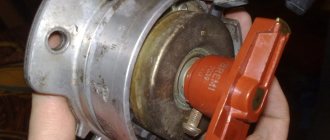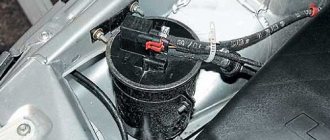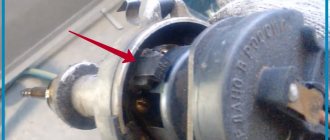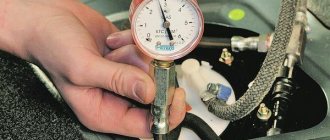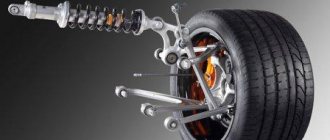In a car, the adsorber absorbs fuel vapor from the gas tank ventilation system and supplies it to the intake, because according to environmental standards, the gas tank must be isolated from the atmosphere.
From Wikipedia ;
Adsorber (from Latin ad - on, with and sorbeo - absorb) is a device for absorbing (thickening) a surface layer of a solid, called an adsorbent (absorber), of dissolved or gaseous substances, not accompanied by a chemical reaction. The adsorber is used in chemical, oil refining and other industries. The process occurring inside this apparatus is called adsorption.
Gasoline vapor filtration system. The diagram is quite conventional, but it reflects the essence. Gasoline vapor from the tank passes through a carbon filter, is cleaned and supplied to the inlet through a solenoid valve controlled by the ECU.
Now the first question is - why filter gasoline vapors if they still go into the intake? The answer is simple - adjusting the internal combustion engine control program by adding the nth number of clean air at the inlet is much easier than making adjustments based on the fuel-air mixture (gasoline vapor from the tank) of an unknown proportion.
And now the answer to the main question - why delete it? So, although some manufacturers claim that this device will have enough resources for the entire life of the car, we know that they are lying)
In general, over time, the adsorber becomes clogged and stops passing air. As a result, we get excess pressure in the tank, which interferes with the normal operation of the fuel pump. In the cabin (sometimes under the hood) we get a periodic smell of gasoline, the vapors of which are squeezed out of the ventilation tube. And the engine starts running on a rich mixture due to lack of air.
Now guess how our country solves this problem? That's right, most people simply throw out the adsorber and turn off the system as shown in the diagram:
A fuel filter from a carburetor classic is usually placed on the tube from the gas tank, and the solenoid valve, through which clean air should flow into the engine, is simply shut off with a bolt.
Where is the adsorber located on the VAZ 2110?
In order to find the adsorber, you need to lift the hood and look in the near left corner, there you will see a small black cylindrical jar.
Replacing the VAZ 2110 adsorber is a simple procedure; it consists of buying a new adsorber, removing the old one and connecting all the hoses in accordance with how they were connected.
That's all for me, the article about the adsorber has come to an end, whoever liked it, comment and share the article on social networks using the special buttons at the bottom of the article. Thank you for your attention, see you again at VAZ Repair.
And now in more detail
How can I check the functionality of this device? The fundamental element in the absorber is the valve. To understand the function, let’s look at how the adsorber works. When a car is parked, a huge amount of gasoline vapor can accumulate in its tank. Some of the vapor is caught by the recuperator, and the rest settles back into the tank. The part that was caught goes into the adsorber. When the engine is running, the absorber valve closes and interrupts the access of vapors, now they are sent to the combustion chamber. What is it for? When you start the car, our device prevents vapors from entering the exhaust manifold, thereby reducing the amount of harmful substances in the gas.
Possible malfunctions in the operation of the device
The VAZ 2114 absorber, due to its intended purpose, is susceptible to clogging and at some point may become faulty. Problems are not easily determined and often only by secondary symptoms, for example, increased pressure in the fuel tank. It’s just that gasoline vapors, due to wear of the separator, remain locked in the space of the tank and begin to put pressure on its walls. An increase in pressure can be detected when unscrewing the tank cap - a characteristic hissing sound is heard.
Sometimes the gas tank cap simply shoots out of the neck, which means that the pressure has reached a critical level and the adsorber must be urgently changed. If there is a problem with the adsorber, the engine speed begins to jump up and down. Many car owners write on forums that you can remove the VAZ absorber and not suffer. But everything is not so simple, and there are never unnecessary parts in cars.
Removing the absorber alone is not enough; you need to think about what to do with gasoline vapors that have nowhere to be discharged, and that the ECU may also have to be reconfigured. After all, some types of on-board engine processors find a malfunction in the purging of the fuel system and put the engine into emergency mode, in which it will not be possible to drive normally.
As for malfunctions, the problem area of this adsorbent system is the purge valve. You can repair it yourself. All you need is a flathead screwdriver, but be careful when removing it. The problem is the valve fastening; often it is not metal, but plastic; it is not difficult to break. The mount is located on the engine cover. There are also clamps on the valve itself, which also require a careful approach. We remove them and take out the problematic part.
If you blow into the valve and air comes out of it, this means a 100% malfunction. A normal part will not allow air to pass through. If there is a problem with the valve, the car experiences problems when starting the engine hot, and gasoline consumption increases. If the problem is not corrected, there will be a Check Engine and loss of normal driving dynamics. Failure of the adsorber seal and failure of the purge valve can cause unstable engine operation at idle until it stops.
So, let's move on to valve repair. In its upper part there is an adjusting screw fixed with epoxy resin. Screw the screw in until it stops, counting the turns so that if something happens, you can return the canister valve to its original position. You can drop a little carburetor flushing fluid into the valve fittings. Then we blow it in the open position with compressed air. The repairs are done.
The valve can also wear out due to heat near the radiator, and there is nothing you can do to help it. The quality of the material from which the adsorber valve is made is not the best. The only solution can be to replace or change the location to a cooler one, for example, closer to the adsorber itself.
How to check the serviceability of a car adsorber - a step-by-step guide
The absorber is designed to absorb fuel vapors from the tank. This part plays an important role in the normal operation of the fuel pump and engine. A malfunction of the device causes a cascade of problems associated with the stability of the power unit. How does the failure of the auto adsorber manifest itself and how to check its serviceability?
What is it needed for
The main role of the adsorber is to capture fuel vapors. The collected vapors are condensed and sent to the intake manifold.
This solves several issues:
- firstly, the level of hydrocarbon emissions into the atmosphere is reduced;
- secondly, the fuel tank is ventilated and the state of rarefaction in it is eliminated;
- thirdly, engine operation is stabilized and gasoline consumption is reduced.
The 5 most unsuccessful modern engines - the cars in which they are installed. Unsuccessful engines create many maintenance problems for the car owner. In the ranking of the most unsuccessful...
There are several signs by which you can identify the problem:
- floating engine speed;
- the engine stalls at idle;
- fuel consumption increases;
- gasoline vapor accumulates in the tank;
- when the power unit is heated, starting it is difficult;
- loss of engine power at low speeds.
A car with a faulty adsorber will continue to drive, but the power unit will no longer operate stable. Operating the machine without cleaning the fuel system from gasoline vapors can lead to damage to the fuel pump.
A button that can check the entire dashboard Today, all modern cars have an instrument panel that informs the driver about the status and stages of...
To identify problems in operation, it is necessary to carry out a step-by-step check:
- Disconnect the car's electrical network from the battery.
- Disconnect all tubes and wires from the device.
- Disconnect the purge valve.
- Using a vacuum tube, attach a syringe to the valve nozzle. When pressure is applied to the syringe piston, resistance should be observed, as a result of which the piston returns to its original position.
- Perform the same manipulation, but with the valve connected to the network. Press the plunger of the syringe and turn on the power to the valve. A “poof” should be heard as a result of the valve opening to relieve pressure.
If the valve does not open, it is beyond repair and must be replaced.
If you hear a hissing sound from the gas tank when you open the cap, what should you do? When unscrewing the gas tank cap of their own car, many car enthusiasts often hear a short hissing...
Checking the performance of a car adsorber becomes necessary as the mileage increases. If poor engine performance or a malfunction of the purge device is detected, the device must be replaced.
Loading... Stay up to date with AUTO news - subscribe to the channel in Yandex.Zen
Types of absorbers used
The topic of environmental protection is relevant for our country. Everyone should do it, especially owners of cars with internal combustion engines. Tons of harmful substances released into the atmosphere every year do not make the world around us cleaner and better.
To improve the environmental situation, an EVAP system is installed on each vehicle, in which the absorber plays a central role. Classification depending on the type of absorbent component.
1. Fixed granular absorbent is used;
2. Mobile granular absorbent is used;
3. A fine-grained absorbent is used, with a constantly boiling bottom layer.
Most automakers use devices that have the first type of design, since it has been proven to be the most effective. Designs of the second and third types also capture spent fuel vapors.
Their main disadvantage is the possibility of absorbent particles entering the atmosphere with spent fuel vapors. Therefore, to maintain an effective operating condition, the volume of absorbent in models with mobile and boiling states requires regular checking. To do this, the absorber must be dismantled.
How the system works - operating principle
Why am I focusing on the solenoid valve, because it is practically the key one in this system.
For a better understanding, I am posting a diagram of an injection car, and in this case it is a VAZ of the 10th family.
So, fuel vapor rises to the top of the tank and stops at the separator, which is combined with a gravity sensor (as I wrote above, it prevents fuel from leaking out in the event of an accident - capsizing from the tank). In it they partially condense and return back (in the form of liquid fuel).
However, the other part of the evaporation bypasses the gravity valve and passes into the adsorber, where they actually accumulate. Accumulation occurs when the engine is not running! IT IS IMPORTANT.
After starting the engine, the solenoid valve opens - thereby connecting the adsorber cavity (where the gases are trapped, as it were) with the intake manifold or throttle assembly (in different cars in different ways). THE PROCESS OF THE SO-CALLED PURGE BEGIN! The vapors are mixed with air (from the street), which is supplied through the throttle assembly, then enter the intake manifold and then into the engine cylinders, where they are burned with the air-fuel mixture.
The system is very simple if you understand how it works.
Operating principle of the adsorber
Adsorption is the process of absorption of gaseous substances by solids or liquids. For example, the first gas masks used filters in which the adsorber was activated carbon. The same thing is done in a car, but a little more complicated. The cylindrical plastic body of the adsorber contains a special filler that traps gasoline vapors. The VAZ 2114 absorber does not end with just a can of filler; pipes and valves are connected to it.
The VAZ absorber does not affect fuel consumption in any way; it is installed only to improve the environmental friendliness of the engine. As the gas tank empties, fuel vapors rise to the neck and enter the separator. There they again turn into a liquid state and return to the tank. And the part that did not have time to condense ends up in an adsorber filled with activated carbon, which absorbs harmful gases. This happens when the engine is turned off.
When the engine is running, the VAZ absorber is purged using a special valve, and all gases are burned in the vehicle’s exhaust system. As for fuel consumption, it varies within insignificant limits. The main purpose of the adsorber is only to neutralize gasoline vapors. This is a container with activated carbon, equipped with inlet and outlet hoses for gasoline vapors.
What's the result?
Considering the above information, it is clear that the canister and the canister valve perform important functions. Moreover, system malfunctions can have a serious impact on engine performance. As a rule, the signs and symptoms of valve problems discussed above often indicate the need for in-depth diagnostics. In this case, the fuel vapor ventilation system is often the culprit.
We also recommend reading the article about what an adsorber is. From this article you will learn about why this device is needed, what functions it will perform, as well as what signs and symptoms indicate that the adsorber is faulty and needs to be checked, serviced or replaced.
For this reason, experienced specialists recommend regularly performing both computer diagnostics of the car and periodically performing mechanical checks (assessing valve performance, engine performance in different modes, etc.). This approach allows you to avoid unexpected breakdowns, as well as significantly increase the overall life of the internal combustion engine, gearbox, and other components, assemblies and systems of the vehicle.
Adsorber VAZ 2115 injector 8 valves
The gas tank of any car always contains vapors formed due to a decrease in atmospheric pressure or heating of the fuel. In order to prevent the leakage of fuel vapors into the vehicle, a special gasoline vapor recovery system (VPSU) is installed. Thanks to it, the vapors retained by the adsorber (essentially activated carbon) enter the intake manifold and burn in the engine cylinders. To regulate the amount of gasoline vapor coming from the adsorber to the manifold, a special solenoid valve is used.
Removal Features
The VAZ absorber is sometimes removed completely. To do this, you need:
- replace the gas tank cap with a leaky one;
- plug the supply and discharge pipes;
- often change the ECU firmware.
As mentioned above, you should not approach the adsorber as an unnecessary thing, and if you decide to remove it, remove it correctly so that the gas tank remains ventilated and not tightly sealed, as if there is an adsorber. Those who convert a carburetor engine to an injection engine have an advantage. If they do not touch the tank pipes, they do not disturb the carburetor ventilation system of the tank, so they do not need an adsorber.
The device of the absorbent element of the car
Externally, the absorber looks like an oblong metal can with two tubes. Through the first, the vapors to be treated are supplied inside, and through the second, condensate is removed. Inside the main body, which has a cylindrical shape and is divided inside by a steel separator into two unequal parts, an absorbent and an evaporator are located.
The separator covers ¾ of the internal diameter, allowing coolant to flow freely through the cylinder. The absorber includes a generator and a capacitor. To prevent their contact, they are separated by an inclined plate. The separator has one half - solid, the other - perforated.
This design allows the absorbent to condense and return if it evaporates. This allows you to maintain the absorbent volume. The settling drops of refrigerant maintain its stable pressure. Subsequently they burn out in the engine.
Canister valve: malfunctions, diagnostics and repairs
It is quite obvious that on any car with an adsorber (Priora, Kalina or foreign car adsorber), the adsorber valve, if it fails, can affect the operation of the internal combustion engine. In other words, both on a domestic budget model (for example, the Kalina canister purge valve) and on a high-class car, this element in some cases is the cause of engine malfunctions.
In fact, a malfunction of the purge valve can damage the fuel pump. Also, if the adsorber ventilation is impaired, fuel may accumulate in the intake manifold, mixture formation is disrupted, the power plant does not produce full power, etc. Problems often appear when starting a cold internal combustion engine; the load on the starter increases when trying to start the engine.
The main symptoms of a malfunctioning adsorber valve:
- the engine is not stable at idle;
- RPM fluctuates at XX;
- engine power lost;
- increased fuel consumption;
- when the internal combustion engine is running, the adsorber valve does not make sounds;
- When unscrewing the gas tank cap, a hissing sound is heard;
- there is a smell of gasoline near the car and in the cabin;
The appearance of such signs may well be caused by other reasons, but often this indicates impaired ventilation of the adsorber. It is for these reasons that experts recommend regularly checking the adsorber valve.
In order to check the adsorber valve, computer diagnostics are sufficient for many cars. A manual check is also useful. As a rule, error codes in the ECU memory will indicate electrical problems (for example, an open circuit error for the canister purge valve).
A mechanical check is needed when, when the engine is idling or cold, you can hear the adsorber valve clicking. If extraneous sounds appear at idle, you can sharply press the gas pedal.
If the clicking sound does not change, then there is a high probability that these sounds are produced by the adsorber valve. So, if the adsorber valve is knocking, first you can try cleaning its adjusting screw, and then tighten this screw.
Next, adjust the absorber valve. To adjust the adsorber valve, turn the adjustment screw 0.5 turns. It should be taken into account that if you tighten the screw too much, the ECU may mistake this for a malfunction and an error will appear.
However, if the adjustment of the adsorber valve is carried out correctly, this valve is practically knock-free. The main thing is to take into account the individual characteristics of a particular valve on a specific car model.
Characteristics of the working absorber
Let's look at some characteristics that allow us to judge the performance of the absorber.
When not in operation, the pressure inside the housing must be equalized with atmospheric pressure.
To prevent the absorption of the absorbent during the passage of the refrigerant, the absorbent liquid must have a stable consistency.
To be able to control the refrigerant flow, it must have a constant temperature.
Both liquids must be mutually soluble.
A prerequisite is high-quality mixture formation between the evaporator and the refrigerant.
Both liquids used must be chemically resistant and completely safe.
There are problems, but everything is whole
Having the above symptoms, and having checked the integrity of the hoses, we move on to the adsorber valve. How to check it?
1) First of all, disconnect the negative terminal from the battery;
2) Remove the absorber (in most cases it is located on the right side of the engine near the car’s air system);
3) Now turn off the electrical power to the valve itself;
4) Remove the hoses (inlet and outlet);
5) Then we try to blow air into the system through the valve (into the holes for the hoses);
6) If it is working, then when the power is removed from it, it will be blocked, i.e. You won't be able to blow it out;
7) Check further. We connect two wires from the battery to the power contacts on the valve. At the same time, you should hear an opening sound (click);
8) When connected to the source, we try to blow air into it. It should work without problems, if not, then it is closed;
9) Reset the power, if it closes again, then it is 100% working.
By checking the adsorber valve in this way, you can determine its performance at almost 100%. Of course, there may be nuances in which this will be more difficult, but the principle is the same everywhere. Thus, we have described in detail how to check this device.
If it is faulty, then you need to buy a new one - the cost is about 2000 rubles, so before you immediately change it, check it. If the problems lie in the operation of the electronic control unit, then this is a completely different story and everything becomes much more complicated.
Now a short video of a VAZ engine.
I’ll finish here, read our AUTOBLOG.
(
10 votes, average: 4.10 out of 5)
Similar news
Do-it-yourself windshield polishing. In different ways + pass.
Different compression in the cylinders. Why and what to do? Let's figure it out.
Source
Operating principle
When the fuel is heated in the engine, the same hydrocarbon vapors appear, which, according to the laws of physics, rise upward into the separator, where most of them condense (return to a liquid state and flow back into the fuel tank, i.e. fuel savings occur). Residual gases are transferred through a steam line to an adsorber filled with activated carbon, which neutralizes them.
While the engine is running, there is another option for getting rid of harmful vapors - by redirecting them from the intake pipe. The temperature there is quite high, and the gas simply burns.
Components
In fact, this is a large plastic jar with activated carbon inside, because it is this composition that perfectly fights gasoline vapors. The main parts can be described as follows:
- Separator + gravity valve
- Pressure meter
- Filter part (usually carbon)
- Connecting tubes
- Solenoid valve
As you can see, there is absolutely nothing complicated. Separator - serves to catch part of the gasoline, then sends it back to the tank. Gravity valve - almost never used, but it is needed in emergency situations, for example during accidents, it prevents fuel from overflowing from the tank (for example, when a car overturns).
